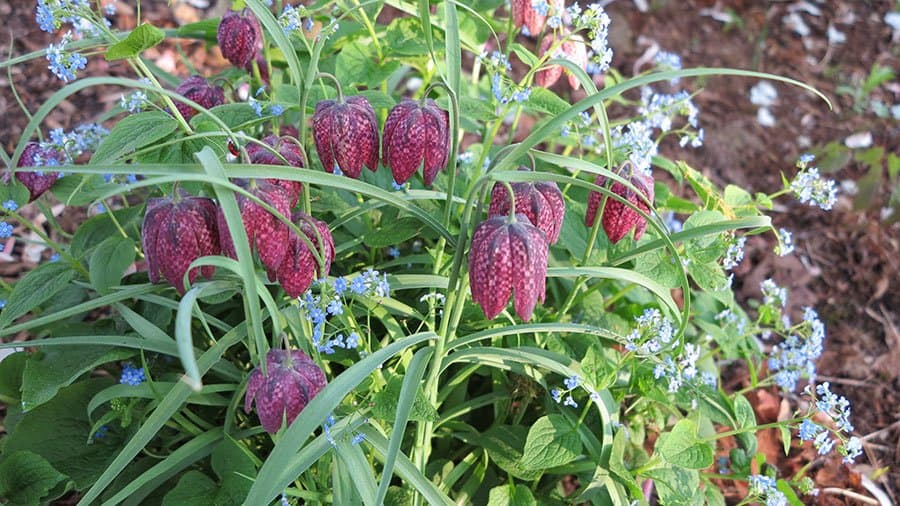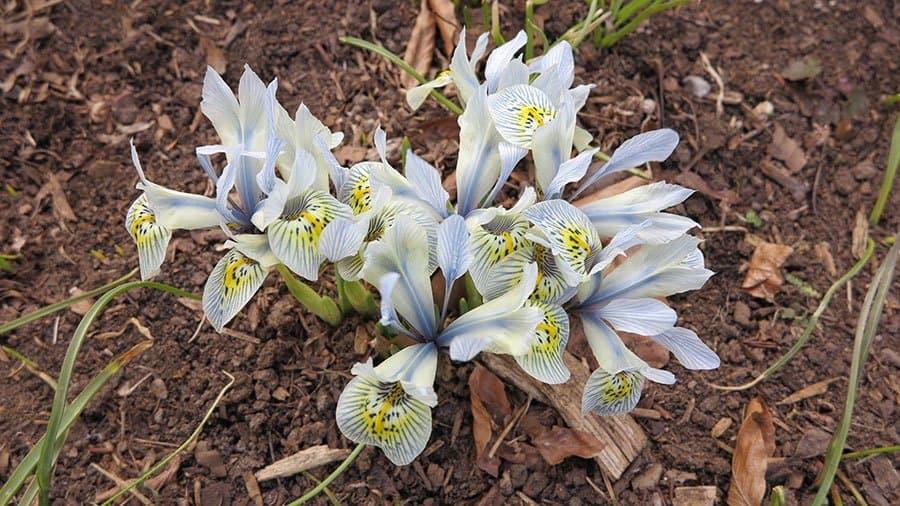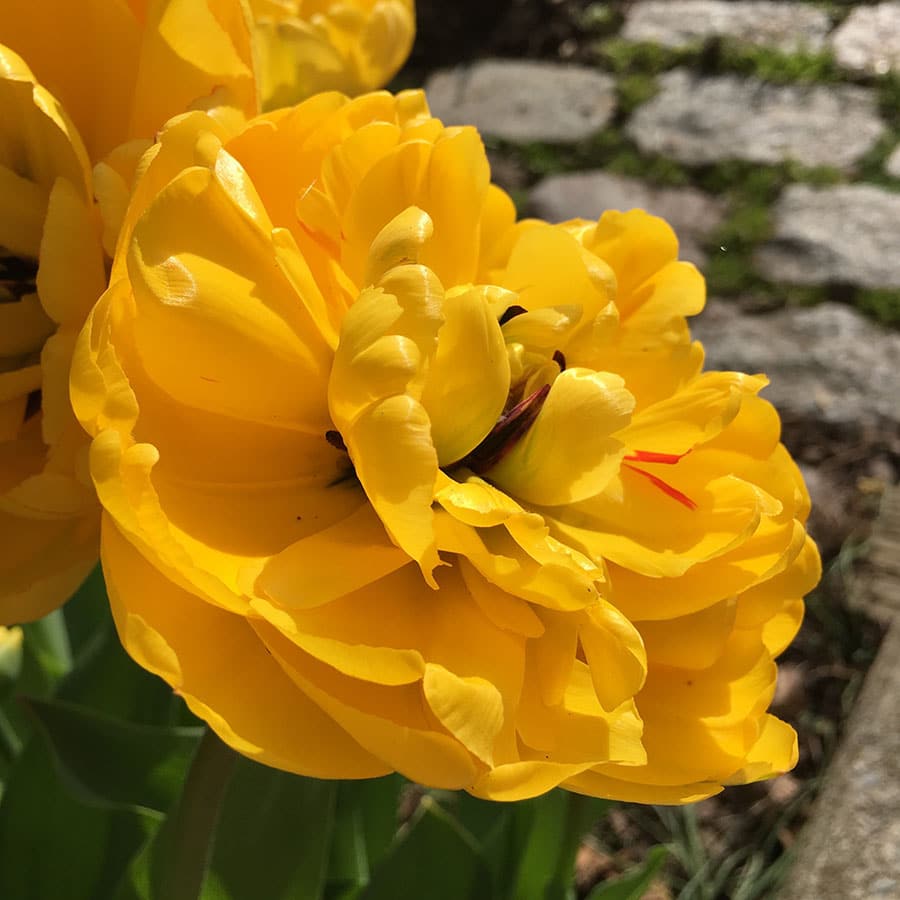It’s a leap of faith. You bury a small, non-descript fibrous mass, not always knowing which end is up. Some bulbs you plant in fall; others you plant in spring and dig up in fall, knowing that winter will turn them to mush. You may well mark where they’re buried, then forget about them. But one day you see signs of growth, and you’re pleased with yourself because you made the effort.
With such a burgeoning variety of bulbs, tubers and corms available, we invited a few gardening industry folks to tell us about their personal favourites — maybe they’ll become your favourites, too.
Beloved Bulbs
Note: this is an expanded list of the “Beloved Bulbs” article in Garden Making No. 27, released August 2016, with recommendations from 7 additional people. List is in no particular order.
1. Robert Wilmott, Vancouver
Master Gardener and board member of Dr. Sun Yat-Sen Classical Chinese Garden
The common snowdrop, Galanthus nivalis, is a favourite bulb of mine, available in many cultivars, beautiful for naturalizing in the garden and providing excellent cut flowers. It pops up in my garden beds and grass in late winter and for me is the first indicator that spring is just around the corner. A delicate bell-shaped flower, its nodding petals appear quite fragile yet still happily seem to survive a late winter snow.
2. Ken Willis, Edmonton
Head of horticulture at Devonian Botanic Garden
My favourite bulb is a species narcissus with a long history of garden use: Narcissus poeticus var. recurvus. It signals the end of early spring and the start of the main perennial and shrub blooming season. I particularly enjoy the glowing white of the perianth, which can complement a number of other plant combinations. The bulb is very winter hardy, long-lived, easy to dig up for division and — important here at Devonian Botanic Garden — it is usually deer-resistant.
3. Karen Achenbach, Annapolis Royal, N.S.
Horticultural manager at Historic Gardens

One of my favourite bulbs is Fritillaria meleagris, or checkered lily. It’s a European native with nodding flowers that sport a delicate, netted pattern. They’re a delight to see mid-spring in our rock garden, and because they seed themselves they pop up in surprising places. They were cultivated as far back as Elizabethan times, and are known by many other names, such as snakeshead fritillary, snakehead flower and guinea hen flower.
4. Liz Hood, Toronto
Outdoor educator, naturalist and urban beekeeper
What’s not to love about species tulips (Tulipa turkestanica)? Hardy, floriferous and prone to naturalizing, they attract early native bees like the Adrena [mining bees] to the garden. Pair these early risers with Muscari, Scilla and Chionodoxa [grape hyacinths, Siberian squill and glory of the snow] for a much-needed hit of colour and life to welcome spring.
5. Frank Ferragine, Bradford, Ont.
Author, gardening expert and weatherman, also known as Frankie Flowers
I love daffodils — ‘King Alfred’ is the perennial favourite. Daffodil bulbs are poisonous to squirrels, they come back stronger year after year and are great naturalizers. Worry-free spring-blooming colour equals perfection!
6. Niki Jabbour, Halifax
Author, radio show host and year-round vegetable gardener
I’m a sucker for the diminutive spring-flowering Chionodoxa, also known as glory of the snow. It grows in both sun and partial shade, resists deer and groundhogs, blooms like crazy for weeks and even self-seeds.
7. David Hobson, Waterloo, Ont.
Speaker, blogger, photographer, and weekly columnist for The Waterloo Region Record
One is enough: Just a single Polianthes tuberosa is outstanding. Tuberose, as it’s commonly called, grows from a tuberous root and blooms August to September, producing a beguiling fragrance to rival any rose. (Flowers are harvested in volume for their oils, extracted for use as the middle note in fine perfumes.) It’s a pretty plant with creamy white tubular flowers along a tall stem. The flowers open at night, and as they do — wow!
8. Dugald Cameron, Toronto
First president of the Greater Toronto Bulb Society and co-founder of the specialty mail-order nursery Gardenimport, which closed in 2014
At Gardenimport, we sold Eucomis (a.k.a. pineapple lily) for more than 30 years with few, if any, complaints. These bulbs are super-easy to grow, needing only a pot, well-draining soil, water and sunlight. They have attractive foliage and spectacular midsummer flowers that last for weeks and weeks. I bring my pots in before frost, put them in a dark corner of my basement and leave them alone until the following spring. They multiply readily so you can share with friends.
9. Sonia Day, Toronto
Author, painter and Toronto Star gardening columnist
‘Queen of Sheba’ tulip was loved by the late, great British gardener Christopher Lloyd. He introduced me to it, and now I love it, too, for its lily-flowered shape — so elegant — and zingy colour — scarlet rimmed with white. Even better, it has lasted for years in my garden and keeps coming back every spring, when other tulips don’t.
10. Larry Hodgson, Quebec City
Gardening tour guide and author

My absolute favourite is a small spring Iris reticulata called ‘Katharine Hodgkin’. It’s one of the first flowers up and has a surprising colouring: pale greenish blue, almost turquoise, with yellow highlights and beautifully intricate markings. It clumps up rapidly, forming dense stands of flowers, and produces a prolific quantity of bulblets. Just dig them up, replant them and you can fill your yard with them in no time. It adapts to any well-drained soil in spots that receive spring sunlight. Hardy to Zone 3 and long-lived, too. A tiny stunner!
11. Mark Cullen, Markham, Ont.
Recent Ontario recipient of the Order of Canada for his contributions to horticultural and environmental education
My favourite spring-flowering bulb is narcissus, which naturalizes beautifully in my 10-acre garden. I’ve planted 20,000 over the past 10 years and they continue to multiply each year. Look for varieties that say “suitable for naturalizing,” as some multiply better than others. (I like ‘Carlton’ in particular.) Narcissus are winter hardy in most parts of Canada, rodent and deer resistant, and they make beautiful cut flowers; some varieties are fragrant. My plan is that my narcissus meadows will outlive me.
12. Tony Spencer, Mono, Ont.
Planting planner and writer who writes The New Perennialist
Nectaroscordum siculum, a lesser-known member of the allium family, snakes up through other plants on a single green stalk, eventually forming what looks like a translucent paper bag on its head. After a few days, the sheath tears open and a cluster of cream-and-ruby bells drops down, dangling over the bed below. Nectaroscordum intermingles exquisitely with perennial companions like astrantia. If you’re lucky, it will self-seed for you.
13. Sara Williams, Saskatoon
Author, horticulturist and Master Gardener program instructor at University of Saskatchewan
My favourite spring bulbs are the Siberian fritillary (Fritillaria pallidiflora), from Siberia, and Michailovski fritillary (F. michailovskyi), from Turkey. Both are perfectly hardy in Saskatoon. The Siberian fritillary is totally adaptable — it tolerates various (well-drained) soils, moisture and light conditions, and naturalizes readily. Michailovski fritillary is very small and cute. You just have to make sure its larger neighbours don’t overrun it.
14. Colleen Zacharias, Winnipeg
Gardening columnist for the Winnipeg Free Press and Master Gardener
In the spring garden, there is no plant more intriguing than Jack-in-the-pulpit (Arisaema triphyllum). Many plants are selected for their showy good looks easily spotted from across the garden. With Jack-in-the-pulpit, the unusual inflorescence is tucked beneath arching three-lobed leaves, inviting observers to peer beneath. Consisting of a striped purple-and-green sheath-like spathe (pulpit) and flower-bearing spadix (Jack), its inflorescence is reminiscent of a calla lily bloom, except it’s covered with a hood that looks a little like a curled tongue. Native to eastern North America, Arisaema grow from tubers, are hardy to Zone 3 and thrive in moist woodland conditions. If including even a single Jack-in-the-pulpit in your spring display elevates it to elegance, picture the impact of amassing several together.
15. Kathy Renwald, Hamilton, Ont.
Garden columnist for the Hamilton Spectator

Tulip ‘Monte Carlo’. It’s strong and long lasting, has vibrant yellow colouring, and has so many petals it’s often mistaken for a peony. Just six bulbs have high impact.
16. Ed Lawrence, Ottawa
During his tenure as head gardener at the National Capital Commission, he oversaw the 85-acre historical grounds and greenhouses of Rideau Hall, and all six official residences
My current favourite is Tulipa praestans ‘Unicum’, an early-blooming species tulip with bright red flowers and showy foliage rimmed in white — plus, each bulb produces several blooms! The variegated foliage greatly extends the period of interest. If you have the space and inclination, repeat groupings throughout your property. As species tulips, they’re likely to naturalize.
17. Donna Balzer, Calgary/Vancouver Island
Garden writer based in Calgary and Vancouver Island
There is nothing predictable about spring on the prairies — it can start in late February or in late May. Then it may be dry, revert back to winter overnight or jump directly into summer. So my all-time favourite bulb here is grape hyacinth (Muscari). It’s a hardy little bulb with tough little blooms that are unfazed by drought or extremes in climate. I want my bulbs to please me all the time, not just some of the time, so even though the bulb I love most is a weed in warmer climates, it’s a treasure here in May, when it carpets the prairie ground with intense, blue blooms.
18. Liz Klose, Niagara-on-the-Lake, Ont.
Honorary Master Gardener of Ontario and former botanical garden director of Memorial University of Newfoundland Botanical Garden in St. John’s
Tumbleweed onion (Allium schubertii) boasts a double exploding starburst ball, which can reach the size of a soccer ball, or larger. It’s made up of several tiny, star-shaped rose-pink flowers. The flower stalk is short, so place it at the front of a border and interplant it among low-growing perennials that will disguise the foliage that starts to decline once flowers emerge. Resist the urge to deadhead — the seed head provides a conversation piece in the garden for some time. After seeds are dispersed, you can use the flower stalks in dried flower arrangements. This bulb has a huge wow factor in the front of any garden. Whether it be in full flower or dried, it reminds me of a huge magic wand.
19. Aldona Satterthwaite, Toronto
Writer and former executive director of Toronto Botanical Garden
While I appreciate the beauty of most spring-flowering bulbs, I tend to choose those that aren’t decimated by squirrels, or scarlet lily leaf beetle, which sadly is now the case with fritillaries (after all, there’s only so much heartache a gardener can take). I also like bulbs that naturalize, such as narcissi, and some of the smaller ephemerals, such as grape hyacinths (Muscari), snow drops (Galanthus nivalis) and Dutch anemone (Anemone coronaria). As for planting, I jumble everything together in a basket, throw the bulbs around by handfuls wherever I want them to go, and then dig them in pretty much where they land.
20. Suzanne Hanna, Sault Ste. Marie
President of the Ontario Horticultural Association
My favourite summer bulb is the gloriosa lily (Gloriosa superba), a tender vine that can be grown on a trellis in a 12-inch (30-cm) container in full sun or dappled shade. Its red-and-yellow flowers bloom in the summer and are worthy of adoration. In northern Ontario, the tubers are lifted and stored in damp peat moss over the winter. (Note that this plant is poisonous; wear gloves when handling.) A glorious addition to any garden!
21. Charlie Dobbin, Toronto
Landscape design and horticultural consultant
Since I’m a gardener always looking for easy plants with minimal maintenance, I have come to truly appreciate grape hyacinths (Muscari armeniacum). The flowers are deep blue/purple and look like miniature fragrant grapes. They easily naturalize and the bees absolutely love them. Sometimes the leaves will grow up in the fall — I think they’re just trying to grab a little extra sunshine before winter hits. Once we have a hard frost, the leaves die back and the little bulbs once again wait until conditions are optimal for flowers.
22. Liz Primeau, Mississauga
Journalist and garden writer
Spring is the showiest time in my garden and picking a favourite is hard, but the lily-flowered ‘Ballerina’ tulip is a star. It has clear orange, reflexed, pointy petals centred with a wide stroke of magenta. Fabulous in a clump with dark purple tulips, like ‘Queen of the Night’ or ‘Black Hero’. Big, long-lasting flowers with a lovely sweet scent.
23. Sarah Nixon, Toronto
My pick is scented narcissus, such as ‘Delnashaugh’. Critters don’t eat them and you can plant them near deciduous trees to get spring sunlight before trees leaf out. They take summer drought, and are a good cut flower. Before mixing cut narcissus with other flowers in a vase, let them sit in water on their own overnight in order to expel the toxic sap that can kill other flowers in an arrangement.

24. Michel Gauthier, Ottawa
Executive director of Canadian Garden Council/Conseil Canadian Du Jardin
I would go with the ‘World Friendship’ tulip, the official tulip of the World Tulip Friendship Society. (I should mention that I’m the chair of the society.) I like its yellow colour and the distinctive shape of its petals. It was named during the 2013 World Tulip Summit in Istanbul, and reminds me that I proposed to my wife in Istanbul!
25. Lorraine Johnson, Toronto
Writer, urban farmer and native plant advocate
I’m a sucker for blue flowers, and native Virginia bluebells (Mertensia virginica) is one of the best—especially since it blooms in early spring when we’re starved for colour. The tubers of this ephemeral woodland plant spread into glorious, cheerful colonies.
(Recommendations condensed and edited.)

Love the chionodoxa that blooms beautifully blue every spring in my Calgary garden. It increases slowly and is always the first thing to bloom. I also have pink chionodoxa but they’re not quite as pretty, IMO.